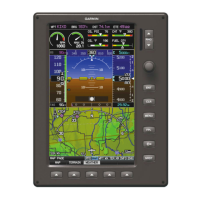190-01115-01 G3X™/G3X Touch™ Avionics Installation Manual
Rev. AV Page 17-6
17.4.2 Mounting Requirements
The GSU 25 contains an extremely sensitive strap-down inertial measurement unit, consider the following
when selecting a mounting location:
• The GSU 25 can be oriented remotely in any of 24 orientations (Figure 17-6
and Figure 17-6), but
must satisfy the mounting alignment requirements along the longitudinal/lateral axes of the
aircraft. The unit can be mounted in any of the 4 cardinal directions with the connectors pointing
up or down can also be mounted on a vertical surface, with the connectors facing up, down,
forward, aft, left, or right.
NOTE
The “Tubes Up” mounting orientations are not recommended as any moisture in the
pitot/static/AOA line could drain into the GSU 25 and damage the pressure sensors.
NOTE
Select the “Tubes Forward/Connectors Down” orientation when the GSU 25 is mounted
to the back of the GDU 4XX unit.
• Although mounting the GSU 25 to the threaded holes on the back of the GDU 4XX display is not
generally recommended due to instrument panel flexing, the “Tubes Forward/Connectors Down”
configuration should be selected when this location is used. Instrument panel material should be at
least 0.063" in thickness to produce satisfactory results.
• Mount the GSU 25 with the connectors aligned within 1.0 degree of either the longitudinal or
lateral axis of the aircraft. The direction of the unit will be accounted for during the calibration
procedure as shown in Figure 17-2
.
• The GSU 25 must be mounted rigidly to the aircraft primary structure through strong structural
members capable of supporting substantial loads, see torque specification listed on Figure 17-5
.
• The supporting plate must be rigidly connected.
• The GSU 25 should be mounted within 13 feet (4.0 meters) longitudinally and 6.5 feet (2.0 meters)
laterally of the aircraft CG (center of gravity). In cases where the longitudinal distance from the
CG is planned to be greater than 6.5 feet (2.0 meters), it is preferable to mount the GSU 25 forward
of the aircraft CG if possible, to enable better acceleration outputs for autopilot use.
• Avoid placing the GSU 25 near sources of vibration or audible noise. Example locations to be
avoided include the engine firewall, near large motors or fans, and audible buzzers and speakers.
• Do not mount the GSU 25 in an enclosed area, it should be mounted in a location that provides
adequate airflow.
• Avoid areas that are prone to severe vibration. Excessive vibration may result in degraded
accuracy.
• Do not use shock mounting to mount the GSU 25. Shock mounts used for other types of inertial
systems are not acceptable for the GSU 25 AHRS. The mounting system must have no resonance
with the unit installed. The unit and mounting structure must not have any resonance with respect
to the aircraft primary structure.
• The wing is not an ideal location to install the GSU 25. Installing a GSU 25 in the wing may
exceed the lateral CG boundary for the unit, exposes the unit to potential wing flex (of which any
amount is a problem), and may expose the unit to unacceptable levels of acoustic noise resulting
from precipitation impacting the leading edge of the wing. These are potential sources of error in
the determination of attitude and should be avoided.

